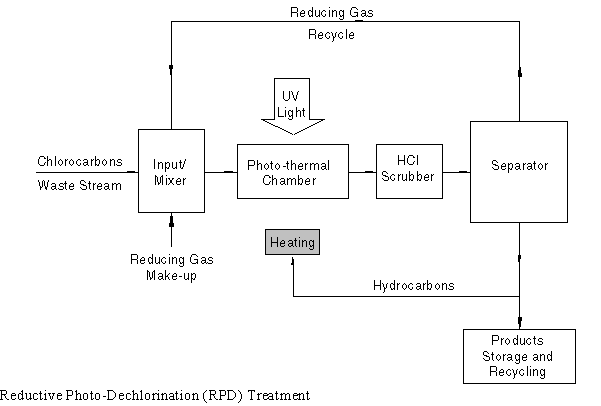
(Reductive Photo-Dechlorination Treatment)
The Reductive Photo-Dechlorination (RPD) treatment uses ultraviolet (UV) light in a reducing atmosphere and at moderate temperatures to treat waste streams containing chlorinated hydrocarbons (CIHC). Because CIHCs are destroyed in a reducing environment, the only products are hydrocarbons and hydrogen chloride (HCl).
The RPD process is schematically depicted in the figure below. The RPD process consists of five main units: (1) input/mixer; (2) photo-thermal chamber; (3) HCl scrubber; (4) separator; and (5) products storage and recycling. Chlorinated wastes may be introduced into the process in one of three ways: as vapor, liquid, or bound to an adsorbent, such as activated carbon. Air laden with chlorocarbon vapors is first passed through a condenser, which removes chlorinated materials as liquids. Chlorocarbon liquids are fed into a vaporizer, mixed with a reducing gas, and passed into the photo-thermal chamber. Chlorinated contaminants adsorbed onto activated carbon are purged with reducing gas and mildly heated to induce vaporization. The ensuing vapors are then fed into the photo-thermal chamber.

The photo-thermal chamber is the heart of the RPD process because all reactions central to the process occur in this chamber. Saturated, olefinic, or aromatic chlorocarbons with one or more carbon-chlorine bonds are exposed to UV light, heat, and a reducing atmosphere, such as hydrogen gas or methane (natural gas). According to M.L. ENERGIA, Inc., carbon-chlorine bonds are broken, resulting in chain-propagating hydrocarbon reactions. Chlorine atoms are eventually stabilized as HCL, which is easily scrubbed. Hydrocarbons may hold their original structures, rearrange, cleave, couple, or go through additional hydrogenation. Hydrocarbons produced from the dechlorination of wastes include ethane, acetylene, ethylene, and methane. Valuable hydrocarbon products can be stored, sold, or recycled as auxiliary fuel to heat the photo-thermal chamber.
The RPD process is designed specifically to treat volatile chlorinated wastes in the liquid, gaseous, or adsorbed state. The RPD process was tested for methylchloride, dichloromethane, chloroform, carbon tetrachloride, trichloroethane (TCA), dichloroethylene, and trichloroethene.
Field applications include treatment of organic wastes discharged from soil venting extraction operations, vented from industrial hoods and stacks, and adsorbed on activated carbon. The process can be used to (1) treat gas streams containing chlorinated hydrocarbons, and (2) pretreat gas streams entering catalytic oxidation systems by reducing chlorine content and protecting the catalyst against poisoning.
The RPD technology was accepted into the SITE Emerging Technology Program in summer 1992. Since then, the RPD technology has successfully completed the bench-scale developmental stage, from which a pilot-scale prototype unit has been construction. The Emerging Technology Bulletin (EPA/540/F-94/508) is available from EPA. Experimental results on a representative chlorocarbon contaminant (TCA) have demonstrated greater than 99 percent conversion and dechlorination, with high selectivity towards two saleable hydrocarbon products, ethane and methane. Similar favorable results have been obtained for other saturated and unsaturated chlorocarbons treated by the RPD process. Preliminary cost analysis shows that the process is extremely cost-competitive with other remedial processes; the estimated cost is less than $1 per pound of treated chlorocarbon. The RPD technology is available for commercialization.
EPA PROJECT MANAGER:
Michelle Simon
U.S. EPA
National Risk Management Research Laboratory
26 West Martin Luther King Drive
Cincinnati, OH 45268
513-569-7469
Fax: 513-569-7676
TECHNOLOGY DEVELOPER CONTACT:
Moshe Lavid
M.L. ENERGIA, Inc.
P.O. Box 470
Princeton, NJ 08542-470
609-799-7970
Fax: 609-799-0312